Abstract
Interleukin 4 (IL-4) exerts a decisive role in the coordination of protective immune responses against parasites, particularly helminths. A disregulation of IL-4 function is possibly involved in the genesis of allergic disease states. The search for important amino acid residues in human IL-4 by mutational analysis of charged invariant amino acid positions identified two distinct functional sites in the 4-helix-bundle protein. Site 1 was marked by amino acid substitutions of the glutamic acid at position 9 in helix A and arginine at position 88 in helix C. Exchanges at both positions led to IL-4 variants deficient in binding to the extracellular domain of the IL-4 receptor (IL-4R(ex)). In parallel, up to 1000-fold increased concentrations of this type of variant were required to induce T-cell proliferation and B-cell CD23 expression. Site 2 was marked by amino acid exchanges in helix D at positions 121, 124 and 125 (arginine, tyrosine and serine respectively in the wild-type). IL-4 variants affected at site 2 exhibited partial agonist activity during T-cell proliferation; however, they still bound with high affinity to IL-4R(ex). [The generation of an IL-4 antagonist by replacing tyrosine 124 with aspartic acid has been described before by Kruse et al. (1992) (EMBO J., 11, 3237-3244)]. These findings indicate that IL-4 functions by binding IL-4R(ex) via site 1 which is constituted by residues on helices A and C.(ABSTRACT TRUNCATED AT 250 WORDS)
Full text
PDF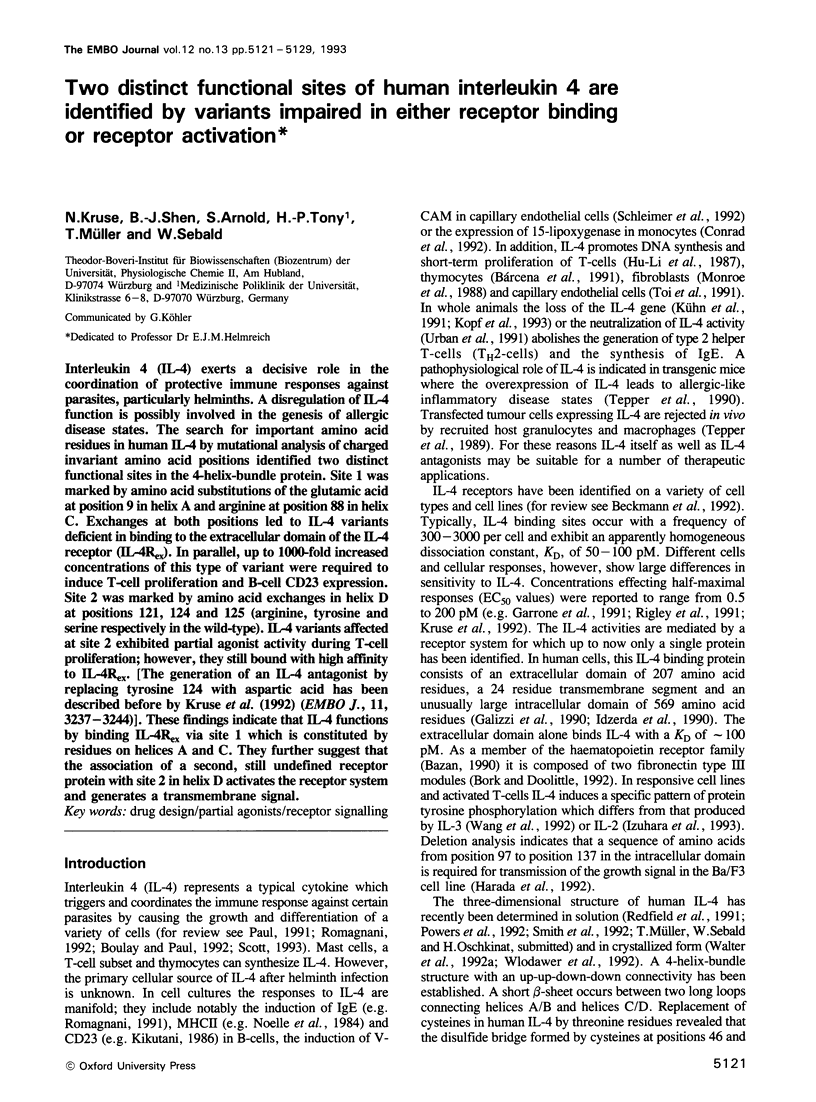
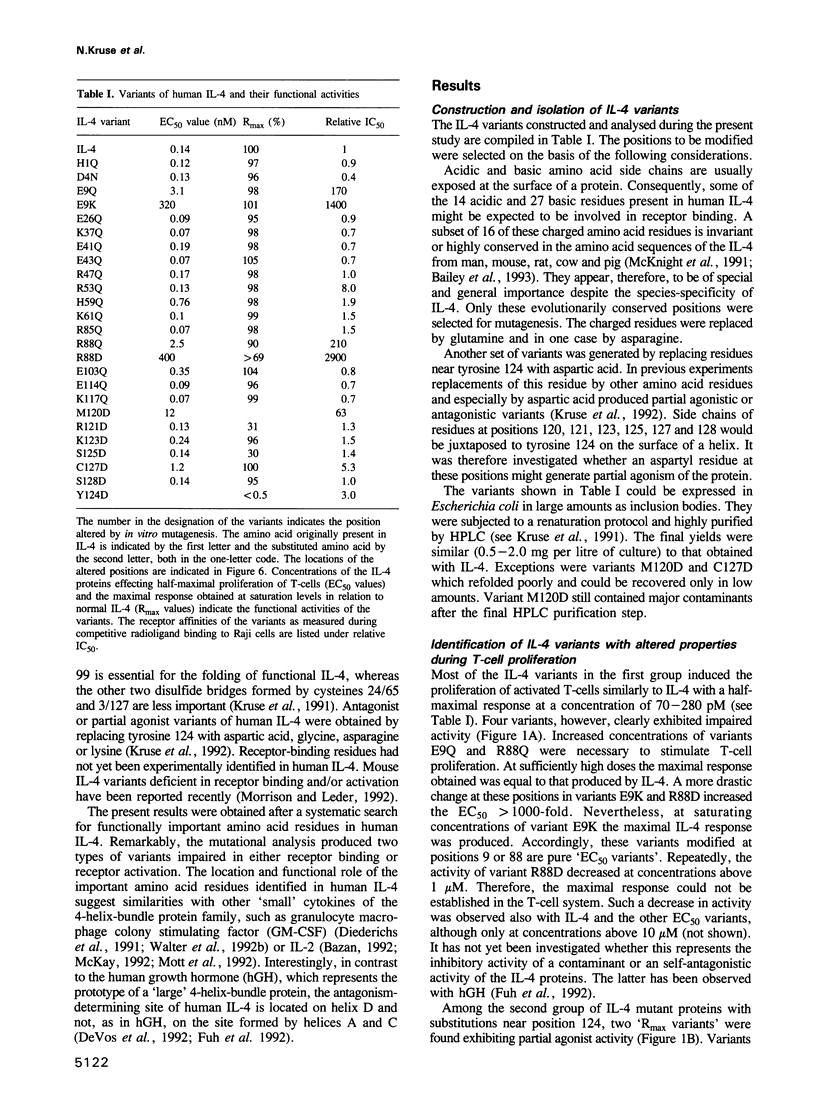
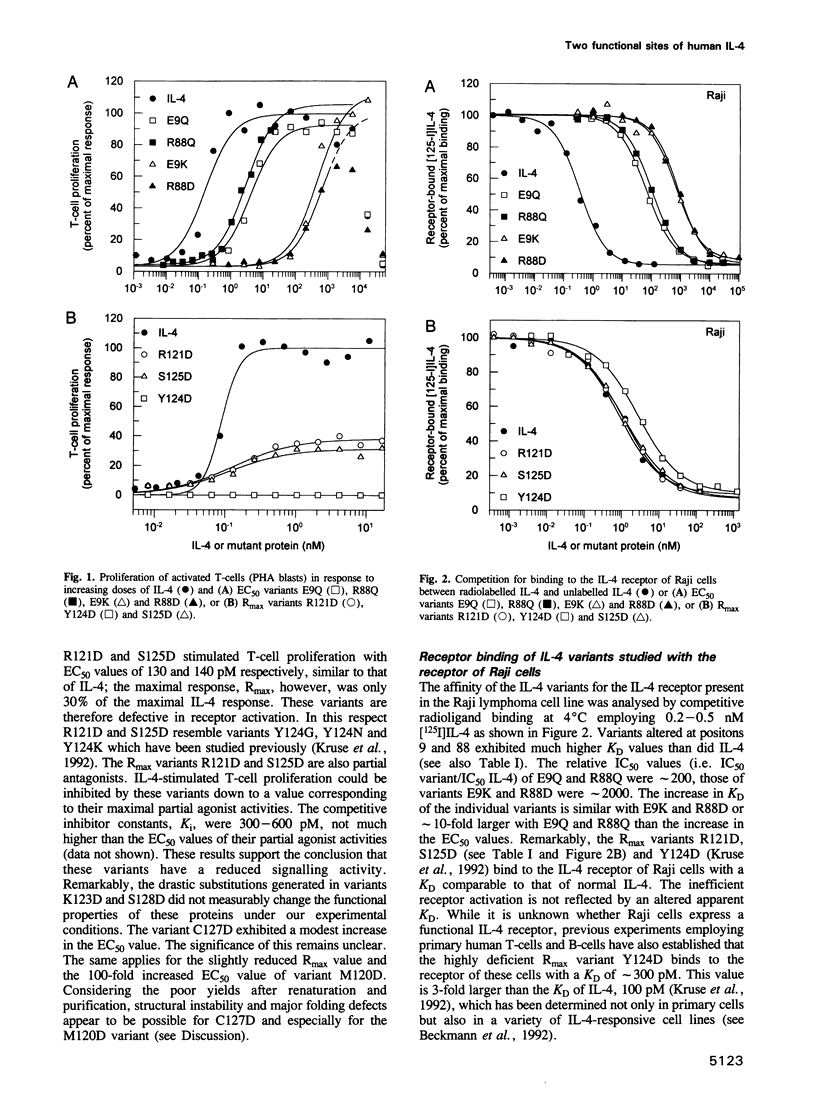
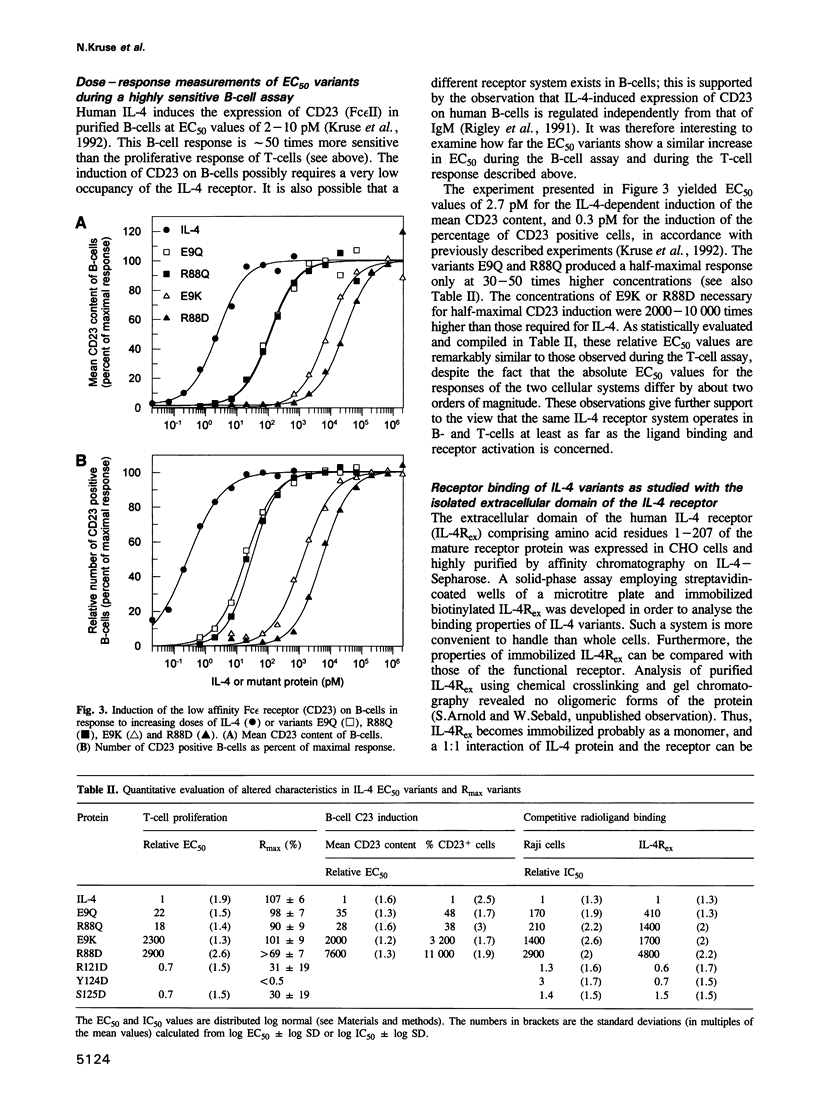
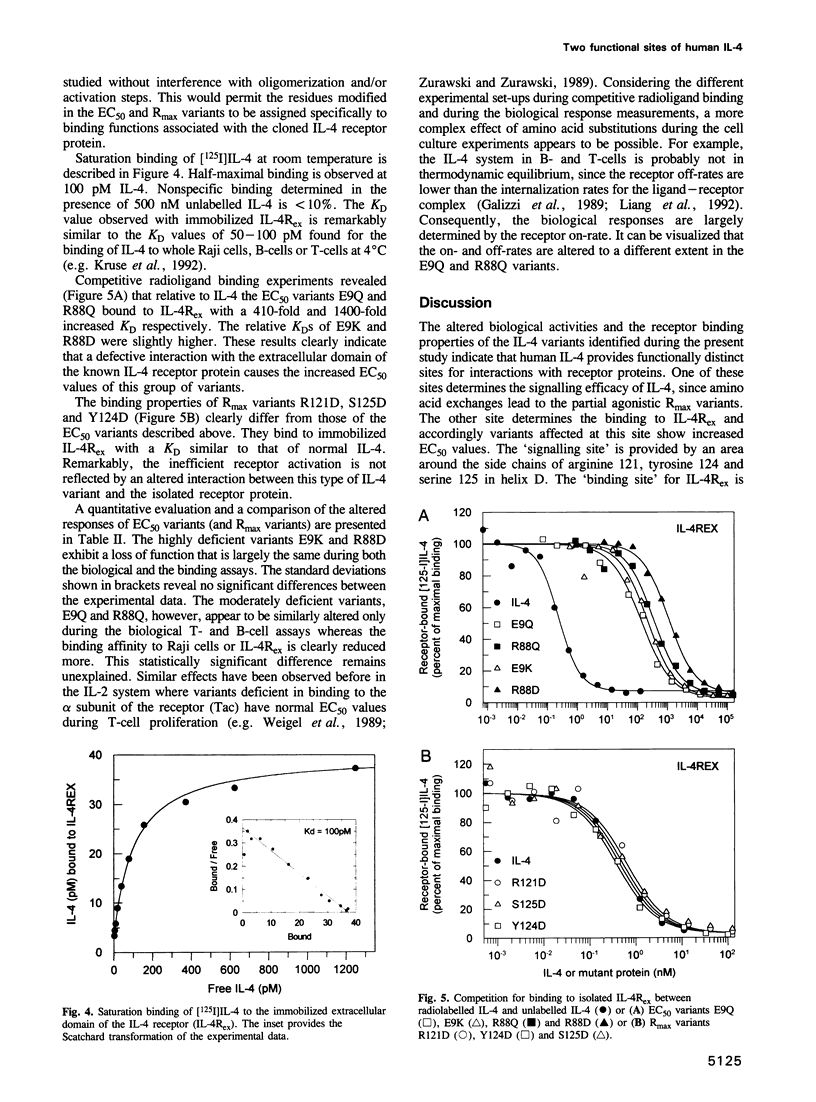
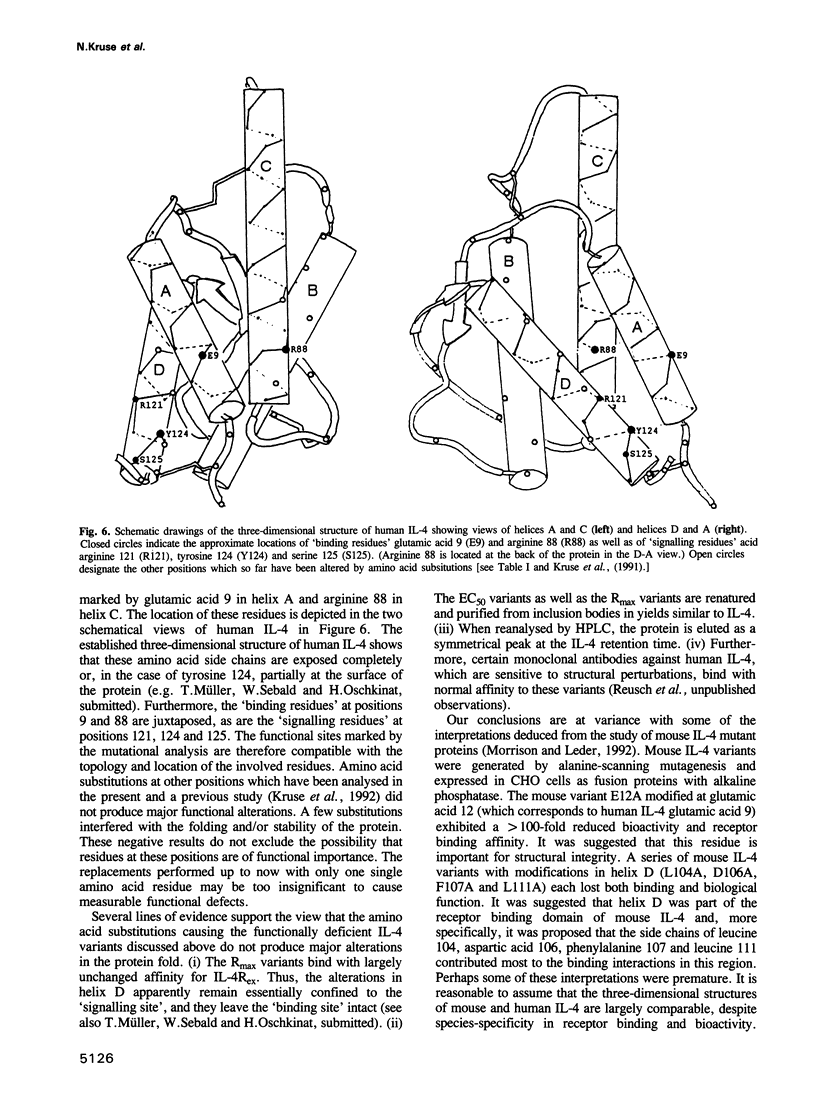
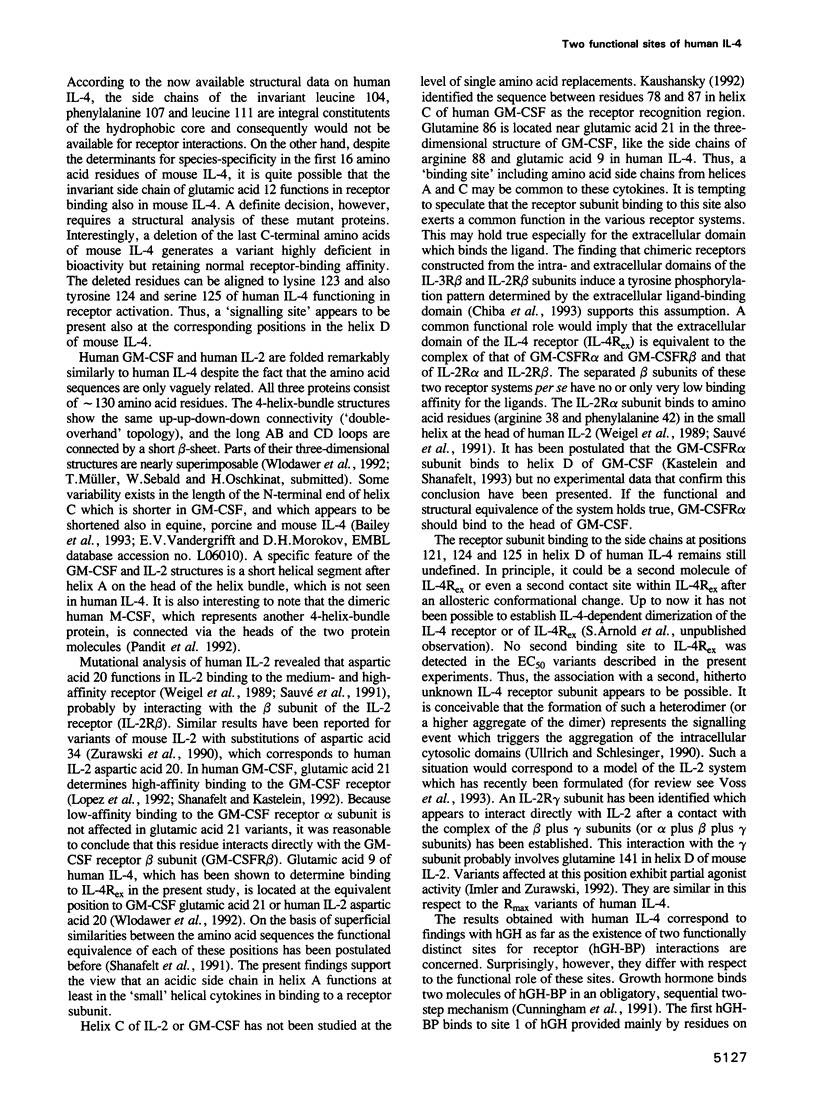
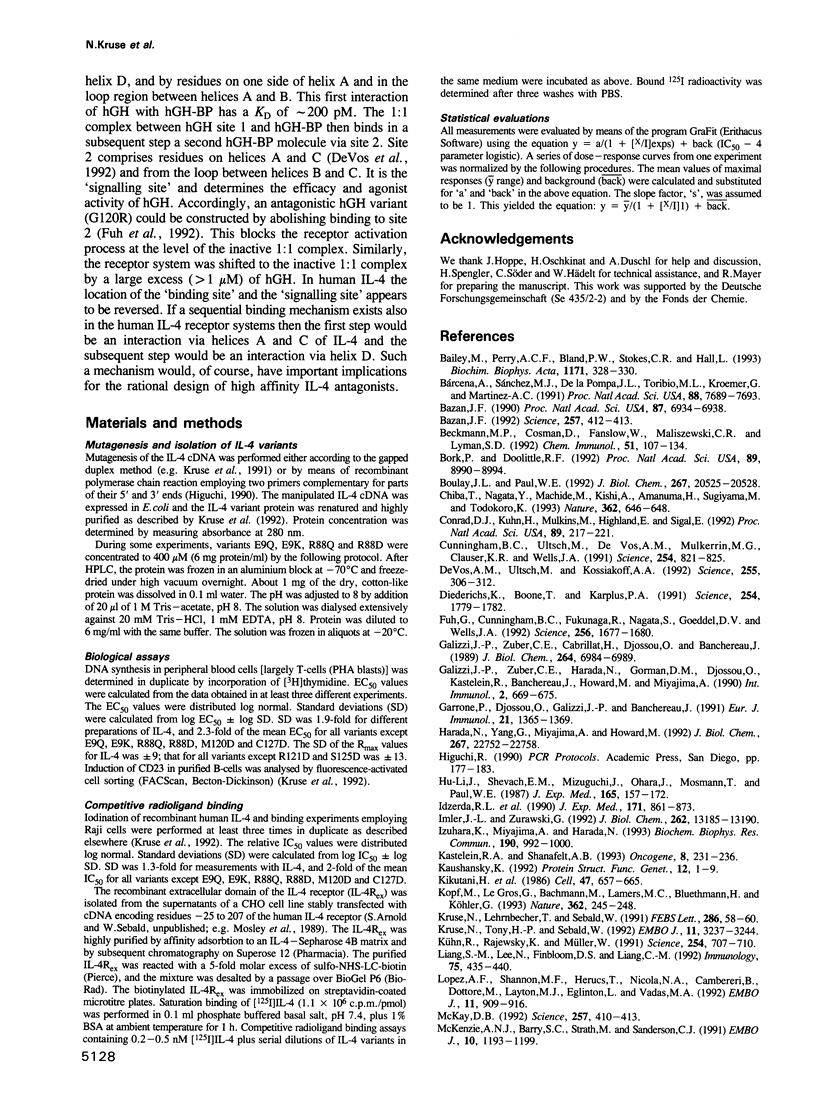
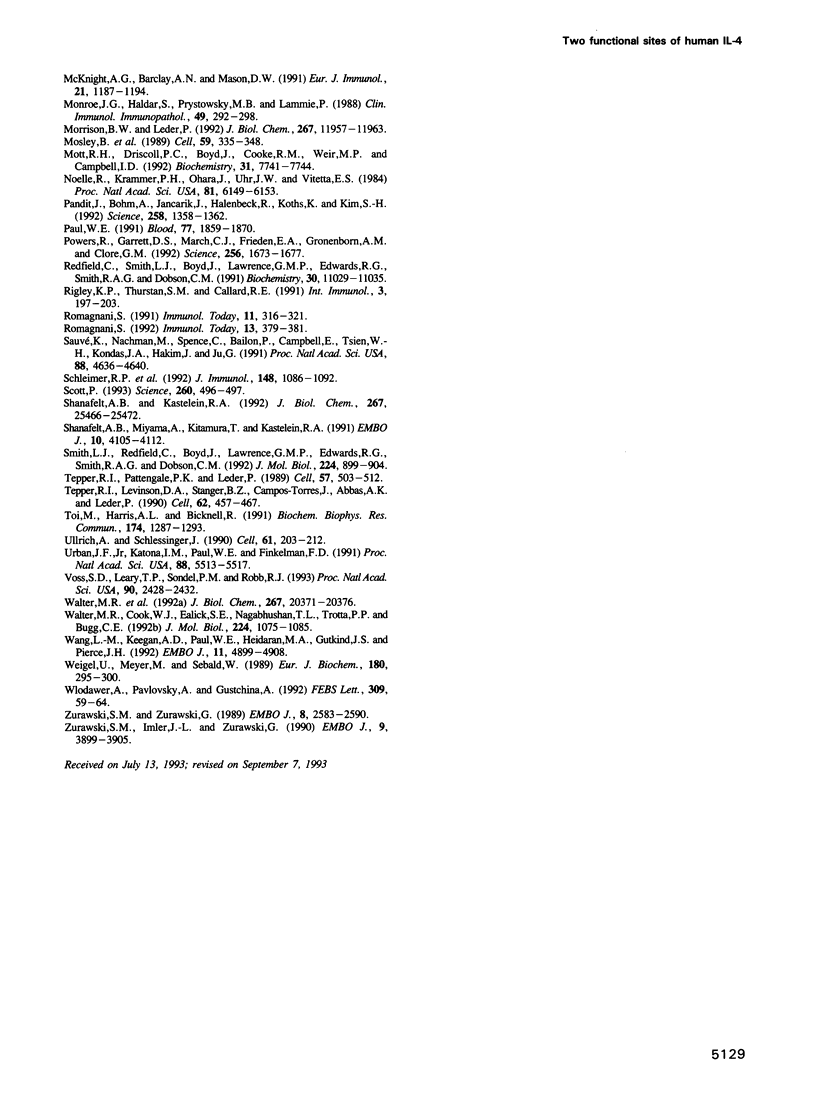
Selected References
These references are in PubMed. This may not be the complete list of references from this article.
- Bailey M., Perry A. C., Bland P. W., Stokes C. R., Hall L. Nucleotide and deduced amino acid sequence of porcine interleukin 4 cDNA derived from lamina propria lymphocytes. Biochim Biophys Acta. 1993 Jan 23;1171(3):328–330. doi: 10.1016/0167-4781(93)90077-q. [DOI] [PubMed] [Google Scholar]
- Bazan J. F. Structural design and molecular evolution of a cytokine receptor superfamily. Proc Natl Acad Sci U S A. 1990 Sep;87(18):6934–6938. doi: 10.1073/pnas.87.18.6934. [DOI] [PMC free article] [PubMed] [Google Scholar]
- Bazan J. F. Unraveling the structure of IL-2. Science. 1992 Jul 17;257(5068):410–413. doi: 10.1126/science.1631562. [DOI] [PubMed] [Google Scholar]
- Beckmann M. P., Cosman D., Fanslow W., Maliszewski C. R., Lyman S. D. The interleukin-4 receptor: structure, function, and signal transduction. Chem Immunol. 1992;51:107–134. [PubMed] [Google Scholar]
- Bork P., Doolittle R. F. Proposed acquisition of an animal protein domain by bacteria. Proc Natl Acad Sci U S A. 1992 Oct 1;89(19):8990–8994. doi: 10.1073/pnas.89.19.8990. [DOI] [PMC free article] [PubMed] [Google Scholar]
- Boulay J. L., Paul W. E. The interleukin-4-related lymphokines and their binding to hematopoietin receptors. J Biol Chem. 1992 Oct 15;267(29):20525–20528. [PubMed] [Google Scholar]
- Bárcena A., Sánchez M. J., de la Pompa J. L., Toribio M. L., Kroemer G., Martínez-A C. Involvement of the interleukin 4 pathway in the generation of functional gamma delta T cells from human pro-T cells. Proc Natl Acad Sci U S A. 1991 Sep 1;88(17):7689–7693. doi: 10.1073/pnas.88.17.7689. [DOI] [PMC free article] [PubMed] [Google Scholar]
- Chiba T., Nagata Y., Machide M., Kishi A., Amanuma H., Sugiyama M., Todokoro K. Tyrosine kinase activation through the extracellular domains of cytokine receptors. Nature. 1993 Apr 15;362(6421):646–648. doi: 10.1038/362646a0. [DOI] [PubMed] [Google Scholar]
- Conrad D. J., Kuhn H., Mulkins M., Highland E., Sigal E. Specific inflammatory cytokines regulate the expression of human monocyte 15-lipoxygenase. Proc Natl Acad Sci U S A. 1992 Jan 1;89(1):217–221. doi: 10.1073/pnas.89.1.217. [DOI] [PMC free article] [PubMed] [Google Scholar]
- Cunningham B. C., Ultsch M., De Vos A. M., Mulkerrin M. G., Clauser K. R., Wells J. A. Dimerization of the extracellular domain of the human growth hormone receptor by a single hormone molecule. Science. 1991 Nov 8;254(5033):821–825. doi: 10.1126/science.1948064. [DOI] [PubMed] [Google Scholar]
- Diederichs K., Boone T., Karplus P. A. Novel fold and putative receptor binding site of granulocyte-macrophage colony-stimulating factor. Science. 1991 Dec 20;254(5039):1779–1782. doi: 10.1126/science.1837174. [DOI] [PubMed] [Google Scholar]
- Fuh G., Cunningham B. C., Fukunaga R., Nagata S., Goeddel D. V., Wells J. A. Rational design of potent antagonists to the human growth hormone receptor. Science. 1992 Jun 19;256(5064):1677–1680. doi: 10.1126/science.256.5064.1677. [DOI] [PubMed] [Google Scholar]
- Galizzi J. P., Zuber C. E., Cabrillat H., Djossou O., Banchereau J. Internalization of human interleukin 4 and transient down-regulation of its receptor in the CD23-inducible Jijoye cells. J Biol Chem. 1989 Apr 25;264(12):6984–6989. [PubMed] [Google Scholar]
- Galizzi J. P., Zuber C. E., Harada N., Gorman D. M., Djossou O., Kastelein R., Banchereau J., Howard M., Miyajima A. Molecular cloning of a cDNA encoding the human interleukin 4 receptor. Int Immunol. 1990;2(7):669–675. doi: 10.1093/intimm/2.7.669. [DOI] [PubMed] [Google Scholar]
- Garrone P., Djossou O., Galizzi J. P., Banchereau J. A recombinant extracellular domain of the human interleukin 4 receptor inhibits the biological effects of interleukin 4 on T and B lymphocytes. Eur J Immunol. 1991 Jun;21(6):1365–1369. doi: 10.1002/eji.1830210606. [DOI] [PubMed] [Google Scholar]
- Harada N., Yang G., Miyajima A., Howard M. Identification of an essential region for growth signal transduction in the cytoplasmic domain of the human interleukin-4 receptor. J Biol Chem. 1992 Nov 15;267(32):22752–22758. [PubMed] [Google Scholar]
- Hu-Li J., Shevach E. M., Mizuguchi J., Ohara J., Mosmann T., Paul W. E. B cell stimulatory factor 1 (interleukin 4) is a potent costimulant for normal resting T lymphocytes. J Exp Med. 1987 Jan 1;165(1):157–172. doi: 10.1084/jem.165.1.157. [DOI] [PMC free article] [PubMed] [Google Scholar]
- Idzerda R. L., March C. J., Mosley B., Lyman S. D., Vanden Bos T., Gimpel S. D., Din W. S., Grabstein K. H., Widmer M. B., Park L. S. Human interleukin 4 receptor confers biological responsiveness and defines a novel receptor superfamily. J Exp Med. 1990 Mar 1;171(3):861–873. doi: 10.1084/jem.171.3.861. [DOI] [PMC free article] [PubMed] [Google Scholar]
- Imler J. L., Zurawski G. Receptor binding and internalization of mouse interleukin-2 derivatives that are partial agonists. J Biol Chem. 1992 Jul 5;267(19):13185–13190. [PubMed] [Google Scholar]
- Izuhara K., Miyajima A., Harada N. The chimeric receptor between interleukin-2 receptor beta chain and interleukin-4 receptor transduces interleukin-2 signal. Biochem Biophys Res Commun. 1993 Feb 15;190(3):992–1000. doi: 10.1006/bbrc.1993.1147. [DOI] [PubMed] [Google Scholar]
- Kastelein R. A., Shanafelt A. B. GM-CSF receptor: interactions and activation. Oncogene. 1993 Feb;8(2):231–236. [PubMed] [Google Scholar]
- Kaushansky K. Structure-function relationships of the hematopoietic growth factors. Proteins. 1992 Jan;12(1):1–9. doi: 10.1002/prot.340120102. [DOI] [PubMed] [Google Scholar]
- Kikutani H., Inui S., Sato R., Barsumian E. L., Owaki H., Yamasaki K., Kaisho T., Uchibayashi N., Hardy R. R., Hirano T. Molecular structure of human lymphocyte receptor for immunoglobulin E. Cell. 1986 Dec 5;47(5):657–665. doi: 10.1016/0092-8674(86)90508-8. [DOI] [PubMed] [Google Scholar]
- Kopf M., Le Gros G., Bachmann M., Lamers M. C., Bluethmann H., Köhler G. Disruption of the murine IL-4 gene blocks Th2 cytokine responses. Nature. 1993 Mar 18;362(6417):245–248. doi: 10.1038/362245a0. [DOI] [PubMed] [Google Scholar]
- Kruse N., Lehrnbecher T., Sebald W. Site-directed mutagenesis reveals the importance of disulfide bridges and aromatic residues for structure and proliferative activity of human interleukin-4. FEBS Lett. 1991 Jul 29;286(1-2):58–60. doi: 10.1016/0014-5793(91)80939-z. [DOI] [PubMed] [Google Scholar]
- Kruse N., Tony H. P., Sebald W. Conversion of human interleukin-4 into a high affinity antagonist by a single amino acid replacement. EMBO J. 1992 Sep;11(9):3237–3244. doi: 10.1002/j.1460-2075.1992.tb05401.x. [DOI] [PMC free article] [PubMed] [Google Scholar]
- Kühn R., Rajewsky K., Müller W. Generation and analysis of interleukin-4 deficient mice. Science. 1991 Nov 1;254(5032):707–710. doi: 10.1126/science.1948049. [DOI] [PubMed] [Google Scholar]
- Liang S. M., Lee N., Finbloom D. S., Liang C. M. Regulation by glutathione of interleukin-4 activity on cytotoxic T cells. Immunology. 1992 Mar;75(3):435–440. [PMC free article] [PubMed] [Google Scholar]
- Lopez A. F., Shannon M. F., Hercus T., Nicola N. A., Cambareri B., Dottore M., Layton M. J., Eglinton L., Vadas M. A. Residue 21 of human granulocyte-macrophage colony-stimulating factor is critical for biological activity and for high but not low affinity binding. EMBO J. 1992 Mar;11(3):909–916. doi: 10.1002/j.1460-2075.1992.tb05129.x. [DOI] [PMC free article] [PubMed] [Google Scholar]
- McKay D. B. Response. Science. 1992 Jul 17;257(5068):412–413. doi: 10.1126/science.257.5068.412. [DOI] [PubMed] [Google Scholar]
- McKenzie A. N., Barry S. C., Strath M., Sanderson C. J. Structure-function analysis of interleukin-5 utilizing mouse/human chimeric molecules. EMBO J. 1991 May;10(5):1193–1199. doi: 10.1002/j.1460-2075.1991.tb08060.x. [DOI] [PMC free article] [PubMed] [Google Scholar]
- McKnight A. J., Barclay A. N., Mason D. W. Molecular cloning of rat interleukin 4 cDNA and analysis of the cytokine repertoire of subsets of CD4+ T cells. Eur J Immunol. 1991 May;21(5):1187–1194. doi: 10.1002/eji.1830210514. [DOI] [PubMed] [Google Scholar]
- Monroe J. G., Haldar S., Prystowsky M. B., Lammie P. Lymphokine regulation of inflammatory processes: interleukin-4 stimulates fibroblast proliferation. Clin Immunol Immunopathol. 1988 Nov;49(2):292–298. doi: 10.1016/0090-1229(88)90119-5. [DOI] [PubMed] [Google Scholar]
- Morrison B. W., Leder P. A receptor binding domain of mouse interleukin-4 defined by a solid-phase binding assay and in vitro mutagenesis. J Biol Chem. 1992 Jun 15;267(17):11957–11963. [PubMed] [Google Scholar]
- Mosley B., Beckmann M. P., March C. J., Idzerda R. L., Gimpel S. D., VandenBos T., Friend D., Alpert A., Anderson D., Jackson J. The murine interleukin-4 receptor: molecular cloning and characterization of secreted and membrane bound forms. Cell. 1989 Oct 20;59(2):335–348. doi: 10.1016/0092-8674(89)90295-x. [DOI] [PubMed] [Google Scholar]
- Mott H. R., Driscoll P. C., Boyd J., Cooke R. M., Weir M. P., Campbell I. D. Secondary structure of human interleukin 2 from 3D heteronuclear NMR experiments. Biochemistry. 1992 Aug 25;31(33):7741–7744. doi: 10.1021/bi00148a040. [DOI] [PubMed] [Google Scholar]
- Noelle R., Krammer P. H., Ohara J., Uhr J. W., Vitetta E. S. Increased expression of Ia antigens on resting B cells: an additional role for B-cell growth factor. Proc Natl Acad Sci U S A. 1984 Oct;81(19):6149–6153. doi: 10.1073/pnas.81.19.6149. [DOI] [PMC free article] [PubMed] [Google Scholar]
- Pandit J., Bohm A., Jancarik J., Halenbeck R., Koths K., Kim S. H. Three-dimensional structure of dimeric human recombinant macrophage colony-stimulating factor. Science. 1992 Nov 20;258(5086):1358–1362. doi: 10.1126/science.1455231. [DOI] [PubMed] [Google Scholar]
- Paul W. E. Interleukin-4: a prototypic immunoregulatory lymphokine. Blood. 1991 May 1;77(9):1859–1870. [PubMed] [Google Scholar]
- Powers R., Garrett D. S., March C. J., Frieden E. A., Gronenborn A. M., Clore G. M. Three-dimensional solution structure of human interleukin-4 by multidimensional heteronuclear magnetic resonance spectroscopy. Science. 1992 Jun 19;256(5064):1673–1677. doi: 10.1126/science.256.5064.1673. [DOI] [PubMed] [Google Scholar]
- Redfield C., Smith L. J., Boyd J., Lawrence G. M., Edwards R. G., Smith R. A., Dobson C. M. Secondary structure and topology of human interleukin 4 in solution. Biochemistry. 1991 Nov 19;30(46):11029–11035. doi: 10.1021/bi00110a004. [DOI] [PubMed] [Google Scholar]
- Rigley K. P., Thurstan S. M., Callard R. E. Independent regulation of interleukin 4 (IL-4)-induced expression of human B cell surface CD23 and IgM: functional evidence for two IL-4 receptors. Int Immunol. 1991 Feb;3(2):197–203. doi: 10.1093/intimm/3.2.197. [DOI] [PubMed] [Google Scholar]
- Romagnani S. Induction of TH1 and TH2 responses: a key role for the 'natural' immune response? Immunol Today. 1992 Oct;13(10):379–381. doi: 10.1016/0167-5699(92)90083-J. [DOI] [PubMed] [Google Scholar]
- Romagnani S. Regulation and deregulation of human IgE synthesis. Immunol Today. 1990 Sep;11(9):316–321. doi: 10.1016/s0167-5699(10)80004-0. [DOI] [PubMed] [Google Scholar]
- Sauvé K., Nachman M., Spence C., Bailon P., Campbell E., Tsien W. H., Kondas J. A., Hakimi J., Ju G. Localization in human interleukin 2 of the binding site to the alpha chain (p55) of the interleukin 2 receptor. Proc Natl Acad Sci U S A. 1991 Jun 1;88(11):4636–4640. doi: 10.1073/pnas.88.11.4636. [DOI] [PMC free article] [PubMed] [Google Scholar]
- Schleimer R. P., Sterbinsky S. A., Kaiser J., Bickel C. A., Klunk D. A., Tomioka K., Newman W., Luscinskas F. W., Gimbrone M. A., Jr, McIntyre B. W. IL-4 induces adherence of human eosinophils and basophils but not neutrophils to endothelium. Association with expression of VCAM-1. J Immunol. 1992 Feb 15;148(4):1086–1092. [PubMed] [Google Scholar]
- Scott P. IL-12: initiation cytokine for cell-mediated immunity. Science. 1993 Apr 23;260(5107):496–497. doi: 10.1126/science.8097337. [DOI] [PubMed] [Google Scholar]
- Shanafelt A. B., Kastelein R. A. High affinity ligand binding is not essential for granulocyte-macrophage colony-stimulating factor receptor activation. J Biol Chem. 1992 Dec 15;267(35):25466–25472. [PubMed] [Google Scholar]
- Shanafelt A. B., Miyajima A., Kitamura T., Kastelein R. A. The amino-terminal helix of GM-CSF and IL-5 governs high affinity binding to their receptors. EMBO J. 1991 Dec;10(13):4105–4112. doi: 10.1002/j.1460-2075.1991.tb04987.x. [DOI] [PMC free article] [PubMed] [Google Scholar]
- Smith L. J., Redfield C., Boyd J., Lawrence G. M., Edwards R. G., Smith R. A., Dobson C. M. Human interleukin 4. The solution structure of a four-helix bundle protein. J Mol Biol. 1992 Apr 20;224(4):899–904. doi: 10.1016/0022-2836(92)90457-u. [DOI] [PubMed] [Google Scholar]
- Tepper R. I., Levinson D. A., Stanger B. Z., Campos-Torres J., Abbas A. K., Leder P. IL-4 induces allergic-like inflammatory disease and alters T cell development in transgenic mice. Cell. 1990 Aug 10;62(3):457–467. doi: 10.1016/0092-8674(90)90011-3. [DOI] [PubMed] [Google Scholar]
- Tepper R. I., Pattengale P. K., Leder P. Murine interleukin-4 displays potent anti-tumor activity in vivo. Cell. 1989 May 5;57(3):503–512. doi: 10.1016/0092-8674(89)90925-2. [DOI] [PubMed] [Google Scholar]
- Toi M., Harris A. L., Bicknell R. Interleukin-4 is a potent mitogen for capillary endothelium. Biochem Biophys Res Commun. 1991 Feb 14;174(3):1287–1293. doi: 10.1016/0006-291x(91)91561-p. [DOI] [PubMed] [Google Scholar]
- Ullrich A., Schlessinger J. Signal transduction by receptors with tyrosine kinase activity. Cell. 1990 Apr 20;61(2):203–212. doi: 10.1016/0092-8674(90)90801-k. [DOI] [PubMed] [Google Scholar]
- Urban J. F., Jr, Katona I. M., Paul W. E., Finkelman F. D. Interleukin 4 is important in protective immunity to a gastrointestinal nematode infection in mice. Proc Natl Acad Sci U S A. 1991 Jul 1;88(13):5513–5517. doi: 10.1073/pnas.88.13.5513. [DOI] [PMC free article] [PubMed] [Google Scholar]
- Voss S. D., Leary T. P., Sondel P. M., Robb R. J. Identification of a direct interaction between interleukin 2 and the p64 interleukin 2 receptor gamma chain. Proc Natl Acad Sci U S A. 1993 Mar 15;90(6):2428–2432. doi: 10.1073/pnas.90.6.2428. [DOI] [PMC free article] [PubMed] [Google Scholar]
- Walter M. R., Cook W. J., Ealick S. E., Nagabhushan T. L., Trotta P. P., Bugg C. E. Three-dimensional structure of recombinant human granulocyte-macrophage colony-stimulating factor. J Mol Biol. 1992 Apr 20;224(4):1075–1085. doi: 10.1016/0022-2836(92)90470-5. [DOI] [PubMed] [Google Scholar]
- Walter M. R., Cook W. J., Zhao B. G., Cameron R. P., Jr, Ealick S. E., Walter R. L., Jr, Reichert P., Nagabhushan T. L., Trotta P. P., Bugg C. E. Crystal structure of recombinant human interleukin-4. J Biol Chem. 1992 Oct 5;267(28):20371–20376. doi: 10.2210/pdb2int/pdb. [DOI] [PubMed] [Google Scholar]
- Wang L. M., Keegan A. D., Paul W. E., Heidaran M. A., Gutkind J. S., Pierce J. H. IL-4 activates a distinct signal transduction cascade from IL-3 in factor-dependent myeloid cells. EMBO J. 1992 Dec;11(13):4899–4908. doi: 10.1002/j.1460-2075.1992.tb05596.x. [DOI] [PMC free article] [PubMed] [Google Scholar]
- Weigel U., Meyer M., Sebald W. Mutant proteins of human interleukin 2. Renaturation yield, proliferative activity and receptor binding. Eur J Biochem. 1989 Mar 15;180(2):295–300. doi: 10.1111/j.1432-1033.1989.tb14647.x. [DOI] [PubMed] [Google Scholar]
- Wlodawer A., Wlodaver A., Pavlovsky A., Gustchina A. Crystal structure of human recombinant interleukin-4 at 2.25 A resolution. FEBS Lett. 1992 Aug 31;309(1):59–64. doi: 10.1016/0014-5793(92)80739-4. [DOI] [PubMed] [Google Scholar]
- Zurawski S. M., Imler J. L., Zurawski G. Partial agonist/antagonist mouse interleukin-2 proteins indicate that a third component of the receptor complex functions in signal transduction. EMBO J. 1990 Dec;9(12):3899–3905. doi: 10.1002/j.1460-2075.1990.tb07610.x. [DOI] [PMC free article] [PubMed] [Google Scholar]
- Zurawski S. M., Zurawski G. Mouse interleukin-2 structure-function studies: substitutions in the first alpha-helix can specifically inactivate p70 receptor binding and mutations in the fifth alpha-helix can specifically inactivate p55 receptor binding. EMBO J. 1989 Sep;8(9):2583–2590. doi: 10.1002/j.1460-2075.1989.tb08397.x. [DOI] [PMC free article] [PubMed] [Google Scholar]
- de Vos A. M., Ultsch M., Kossiakoff A. A. Human growth hormone and extracellular domain of its receptor: crystal structure of the complex. Science. 1992 Jan 17;255(5042):306–312. doi: 10.1126/science.1549776. [DOI] [PubMed] [Google Scholar]


